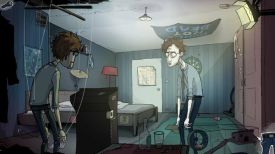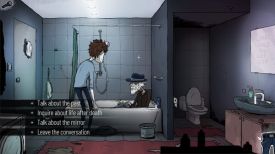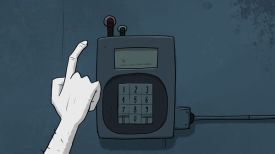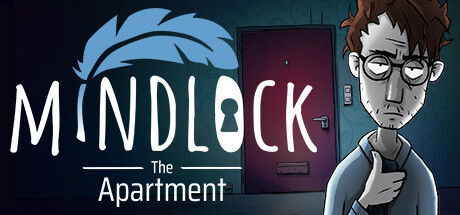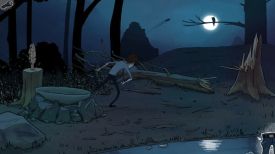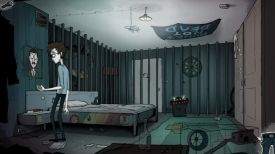|
By flotsam
Mindlock - The Apartment
Roof Cut Media
Drawn to it initially by the
visual style (Tim Burton and Gorillaz were apparently general
inspirations and I can see both), I wasn’t sure what I thought early on
but ended up feeling very positive about the time I spent with Colin.
We first meet Colin waking in
his bedroom, rousing himself to spend another day at his monotonous job
as he has done many unsatisfying days before. Except his front door is
missing, and his apartment is no longer what it seems. Getting out is
the least (or most) of his worries, as his predicament forces him to
confront the bits and pieces of his life that have led him to this
point.
Not to mention the cryptic
messages on his bathroom mirror, the puppet in his bedroom, and the
bloated caricature of his boss eventually emerging from the toilet.
I thought that Mindlock did a
good job of portraying the labyrinth that is Colin’s life, in ways that
didn’t always make immediate sense but which spoke of how they impacted
his here and now. Which is not somewhere he really wants to be, but is
somewhere he is stuck unless and until he stares down the emotional
challenges in his past and ultimately takes different paths. And his
hunched posture speaks volumes.
This is one game where exploring
and clicking the environment benefits the bigger story. Colin’s insights
help build a more complete picture of who he is and what he faces. Steam
achievements also suggest there is much to be done that isn’t necessary,
but are a product of complete clicking.
Much of the puzzling is
inventory based, but there are a few out and out puzzles. Kudos to the
makers for listening to feedback about a couple of them, and providing
patches to make them less problematic. There are also some conundrums
that require a bit of timing, which can be managed one step at a time,
albeit by doing the same thing.
Then there are the mind games.
These tended to be a bit too random in their solution for my liking but
they weren’t all like that. And I warmed to them a bit more as the game
went on, as I better appreciated their place in the narrative. Plus, the
different visual style provided a counterpoint in more ways than one. As
straight out puzzles though they remained a mix bag (and were
responsible for my early-on feelings).
The scene in front of you is
explored with the mouse, and won’t slide or scroll. Little footsteps
will indicate you can go elsewhere, whereupon a new scene will load if
clicked. Hotspots (which are fairly generous) can be highlighted with
the space bar or by clicking the little torch top left. Icons will
indicate what can be done (pretty much look or take) and the ‘flipped’
left and right mouse was a nice touch in the context of the game.
It plays in the third person and
is hand drawn and animated. A lot of effort and thought has clearly gone
into its depiction, and the game’s website provides more elaboration of
the visual journey should you be interested.
The maker says that “you can
expect a lot of wry humour between hard reality and mystical elements”
and I think that’s a fair assessment on all three counts. Everything is
voiced, all rather well, and ambient sound and a suitable soundtrack
round out the auditory pallet. The inventory is accessed through the
pants icon bottom right. It exclusively autosaves, but frequently enough
not to be an issue.
Four to six enjoyable hours
should see you through.
I played on:
OS:
Windows 10, 64 Bit
Processor: Intel i7-9700K 3.7GHz
RAM:
Corsair Dominator Platinum RGB DDR4 32GB
Video
card: AMD Radeon RX 580 8192MB
GameBoomers Review Guidelines
December 2024
design copyright© 2024
GameBoomers
Group
 GB
Reviews Index GB
Reviews Index |
